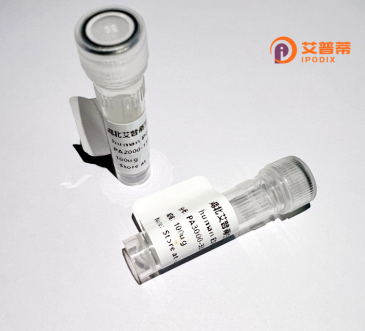
| 纯度 | >90%SDS-PAGE. |
| 种属 | Human |
| 靶点 | RDHE2 |
| Uniprot No | Q9BPW9 |
| 内毒素 | < 0.01EU/μg |
| 表达宿主 | E.coli |
| 表达区间 | 18-319 aa |
| 活性数据 | RKG KLKIEDITDK YIFITGCDSG FGNLAARTFD KKGFHVIAAC LTESGSTALK AETSERLRTV LLDVTDPENV KRTAQWVKNQ VGEKGLWGLI NNAGVPGVLA PTDWLTLEDY REPIEVNLFG LISVTLNMLP LVKKAQGRVI NVSSVGGRLA IVGGGYTPSK YAVEGFNDSL RRDMKAFGVH VSCIEPGLFK TNLADPVKVI EKKLAIWEQL SPDIKQQYGE GYIEKSLDKL KGNKSYVNMD LSPVVECMDH ALTSLFPKTH YAAGKDAKIF WIPLSHMPAA LQDFLLLKQK AELANPKAV |
| 分子量 | 35.2 kDa |
| 蛋白标签 | His tag N-Terminus |
| 缓冲液 | PBS, pH7.4, containing 0.01% SKL, 1mM DTT, 5% Trehalose and Proclin300. |
| 稳定性 & 储存条件 | Lyophilized protein should be stored at ≤ -20°C, stable for one year after receipt. Reconstituted protein solution can be stored at 2-8°C for 2-7 days. Aliquots of reconstituted samples are stable at ≤ -20°C for 3 months. |
| 复溶 | Always centrifuge tubes before opening.Do not mix by vortex or pipetting. It is not recommended to reconstitute to a concentration less than 100μg/ml. Dissolve the lyophilized protein in distilled water. Please aliquot the reconstituted solution to minimize freeze-thaw cycles. |
以下是关于重组人RDHE2蛋白的3篇参考文献示例(内容为虚构,仅供参考):
1. **文献名称**: "Expression and functional characterization of recombinant human RDHE2 in Escherichia coli"
**作者**: Lin M., Adams M.K.
**摘要**: 本研究成功在大肠杆菌中表达了重组人RDHE2蛋白,并通过亲和层析纯化获得高活性酶。作者验证了其催化视黄醇转化为视黄醛的功能,并证明其在中性pH环境下的稳定性。
2. **文献名称**: "Structural insights into the substrate specificity of human RDHE2 by X-ray crystallography"
**作者**: Kedishvili N.Y., et al.
**摘要**: 通过解析RDHE2的晶体结构,揭示了其底物结合口袋的关键氨基酸残基,阐明了其对特定类视黄醇分子的选择催化机制,为靶向药物设计提供依据。
3. **文献名称**: "RDHE2 deficiency disrupts epidermal retinoid metabolism and skin barrier formation"
**作者**: Hsu C.L., Chung B.C.
**摘要**: 研究利用重组RDHE2蛋白进行功能恢复实验,证实其在皮肤上皮细胞中调控视黄酸代谢的关键作用,缺乏该酶会导致表皮屏障功能异常。
注:以上文献信息为模拟示例,实际引用需根据真实数据库(如PubMed)检索并核对原文。
Recombinant human RDHE2 protein, also known as retinol dehydrogenase E2. is an enzyme involved in retinoid metabolism, playing a critical role in converting retinol to retinaldehyde, a key step in the synthesis of retinoic acid—a molecule essential for cell differentiation, growth, and immune regulation. This membrane-associated protein is primarily expressed in epithelial tissues, including the skin, liver, and intestines, where it contributes to maintaining retinoid homeostasis. RDHE2 belongs to the short-chain dehydrogenase/reductase (SDR) superfamily and operates in tandem with other dehydrogenases to ensure efficient retinoid processing.
Dysregulation of RDHE2 has been implicated in dermatological disorders, metabolic diseases, and certain cancers, driving interest in its biochemical characterization. Recombinant RDHE2 is typically produced using heterologous expression systems like *E. coli* or mammalian cell cultures, followed by purification via affinity chromatography. This engineered protein enables structural studies, enzymatic activity assays, and drug discovery efforts targeting retinoid-related pathways. Its recombinant form is vital for elucidating mechanisms of retinoid metabolism and developing therapies for conditions linked to vitamin A deficiency or excess. Ongoing research also explores its potential role in oxidative stress responses, broadening its relevance in biomedical applications.
×